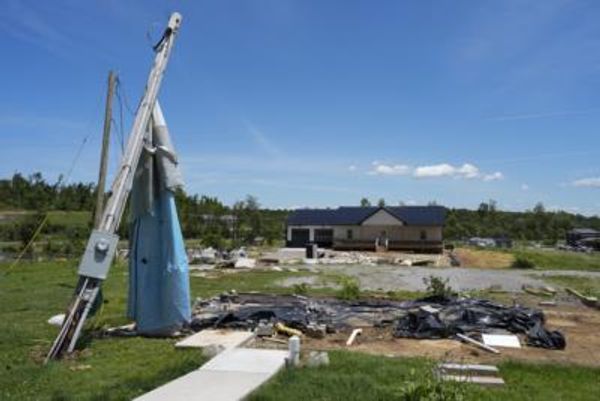
Almost a decade has passed since former Baxter International director Henry Murphy worked at the corporation’s Deerfield area headquarters.
But for him, the 101-acre modernist campus remains unforgettable.
“Trees, a lake — and the size of it all,” he remembered last week. “You had this huge cafeteria that looked over the grounds. And the sheer number of people [the cafeteria held],” Murphy said. “I mean, that was a spectacular room.”
Built in the 1970s for medical giant Baxter International, the campus symbolizes a time when sprawling suburban corporate headquarters built in park-like settings were quite the thing.
The best of them represent a high point in midcentury architecture: horizontal masterpieces that are every bit as important as their downtown vertical contemporaries.
But while Chicago and other big cities have managed to either reuse or protect midcentury skyscrapers, suburban corporate centers like the Baxter campus are an endangered breed.
Bridge Industrial wants to wreck the superlative 10-building Baxter HQ. And demolition would claim Baxter’s Central Facilities Building — the remarkable edifice with the 700-seat cafeteria Murphy remembers.
Central Facilities’s open interior is free of structural columns, its roof held aloft by cables attached to twin 30-foot masts atop the building.
The campus was designed by Bruce Graham and structural engineer Fazlur Khan — the SOM dynamic duo who created the Sears Tower and the John Hancock Center. The grounds are the design of renowned landscape specialists Sasaki.
And what will rise from the rubble if all this thoughtful design comes crashing down?
About 1.3 million square feet of warehouses and logistics space, plus a new public community center.
That, and a massive case of architectural heartbreak of the first order.
Baxter and the corporate Shangri-La
While big corporations have relocated downtown in recent years, the action was in the north, northwestern and western suburbs in the mid and late 20th century.
Cheap land, friendly zoning, and proximity to O’Hare and the interstates lured companies into building expansive, climate-controlled corporate shangri-las far from the then-decaying city by the lake.
Then times changed. Companies downsized. The city rebounded, and younger workers this century wanted to be there.
And when the pandemic caused more people to work from home, the suburban corporate campus — big and emptying — started looking like an obsolete building type.
If the Baxter headquarters falls, it will join other high-line midcentury suburban Chicago corporate campuses that have been turned to dust.
Motorola’s 322-acre campus at I-90 and Meacham Road was demolished beginning in 2018 and is being redeveloped as residential, commercial and open space.
And in 2022, Allstate sold off 3.2 million square feet of its headquarters. The landscaped campus of some pretty fine-looking 1960s and 1970s office spaces was annexed into Glenview and demolished, replaced by logistics and e-commerce buildings.
“You know what struck me when I heard about Baxter?” said retired SOM Managing Partner Richard F. Tomlinson II. “It just struck me as another example of how the community at large doesn’t appreciate this work.”
“Why can’t you think about how to reuse this building?” he said.
Tomlinson’s right. The Ace Hardware company moved into McDonald’s 80-acre Oak Brook campus once the fast food purveyor left for Chicago.
And Chicago’s Old Main Post Office — once so much of a lifeless white elephant, it deserved space in the Field Museum — now enjoys a vibrant new life.
“It could be a small college, like a little commuter campus for a college,” said Tomlinson, who worked on the Central Facilities cafeteria’s design with architect Brigitte Peterhans.
“There are a number of things that you could start thinking about if you engage — actually engage — the community.”
Not yet a done deal
Bridge Industrial wants Deerfield to annex the Baxter property, then approve the redevelopment plan.
But Deerfield homeowners are fighting the effort, citing concerns over traffic, noise and fumes from the center, once built.
A plan commission meeting on the matter has been set for May 11.
Architect David Fleener, a board member of the modernist preservation group DOCOMOMO-Chicago, plans to testify against the project.
“We would encourage Deerfield to encourage a sustainable reuse of the [campus],” he said.
Also, Landmarks Illinois sounded the alarm last week by placing Baxter on its 2023 Most Endangered Buildings list.
Meanwhile, Murphy, a Chicago Cultural Alliance board member, is an executive in North Carolina now. But he’s kept up with Baxter’s possible fate.
“It’s not like some sexy Victorian greystone,” Murphy said. “But in its own way, it’s art that takes us back and gives us a view to corporate America of a different time. Losing it does seem like a waste.”
Lee Bey is the Chicago Sun-Times architecture critic and a member of the Editorial Board.
Send letters to letters@suntimes.com







